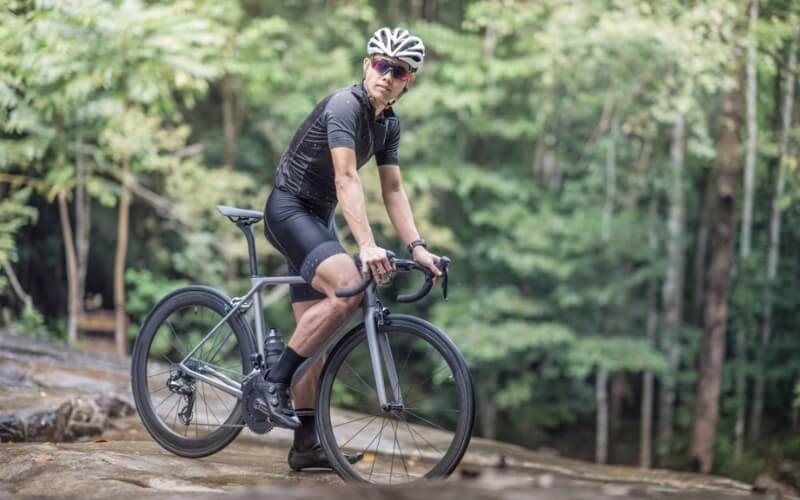
Mountain biking is an excellent way to boost your fitness, combining aerobic, intensive, and interval training into one activity. It increases your heart rate, improves breathing, lowers your resting heart rate, and enhances your body’s oxygen uptake.
Weight loss comes down to one simple principle: a negative energy balance. You need to burn more calories than you consume. Mountain biking helps achieve this by increasing your basal metabolic rate, making it an effective and enjoyable way to shed those extra pounds.
If you’re looking to lose weight, mountain biking paired with a balanced diet can be the perfect solution. It’s a sport that’s easy to enjoy, even if you’re not a fan of traditional workouts or make excuses. Even beginners with no prior training can start mountain biking and see progress.
How to Lose Weight on a Mountain Bike
Let’s see our 10 tips on mountain biking for weight loss.
1. Riding Duration and Speed
The effectiveness of fat burning during mountain biking is closely tied to your body’s oxygen supply. Fat oxidation requires large amounts of oxygen, and endurance sports like mountain biking help increase your body’s oxygen absorption capacity. To optimize fat metabolism, keep your exercise intensity below 70% of your maximum effort.
For those focused on fat loss, it’s crucial to strike a balance between the duration of your ride and your speed. If you’re a hobby cyclist aiming to improve fat metabolism, long rides at a steady and moderate pace are ideal. On the other hand, experienced riders who want to both lose weight and enhance performance can gradually interweave higher intensity while still focusing on endurance.
2. Correct Heart Rate for Fat Burning
Maintaining the correct heart rate is crucial for effective weight loss during mountain biking. To find your optimal fat-burning zone, a common method is to subtract your age from 220 for men and 226 for women—this gives your estimated maximum heart rate. The ideal fat-burning zone is 60-70% of this number.
Smart devices can make this process even easier. These gadgets monitor your heart rate and fitness level in real time, adjusting your target training zone to your current condition.
3. Healthy Eating Promotes Weight Loss
Weight loss through mountain biking is most effective when paired with a balanced diet. The type of diet—whether low-carb, slow-carb, or ketogenic—matters less than maintaining a consistent calorie deficit. Prioritize whole, unprocessed foods that provide the necessary macro and micronutrients to fuel your body while keeping calories in check.
A nutrient-rich diet helps boost your metabolism, which in turn promotes fat burning. While athletes rely on carbohydrates like pasta, rice, and bread for peak performance during competitions, those focused on weight loss should reduce their intake of these carb-heavy foods to stay on track.
4. Training Plan for Beginner Bikers
If you’re new to mountain biking, start with two to three rides per week, each lasting two to three hours. Your heart rate should remain in the Basic Endurance 1 range (G1), which is ideal for building a solid aerobic base and promoting fat burning. As you progress, you can increase the intensity to achieve the same weight loss effects.
For advanced riders, aim for three to four rides per week, still lasting two to three hours, but combining both G1 and G2 heart rate zones. Training at a higher intensity burns more calories overall, even though the percentage of fat burned decreases. For example, training at 70% of your maximum heart rate for an hour burns around 300 calories, with 50% coming from fat. However, at 80% of your max heart rate, you’ll burn 600 calories in the same hour, with 40% being fat—resulting in 240 calories from fat. Essentially, higher intensity leads to greater fat loss overall.
5. Prioritize Rest and Recovery
Rest days are just as essential as the training itself, allowing your body to recover and adapt. Make sure your training plan includes sufficient rest for optimal results. After each ride, focus on a high-protein, low-fat meal to support muscle recovery. Keep carbohydrates like bread, pasta, and rice to a minimum, even post-exercise, and instead prioritize vitamins, minerals, and healthy fats from vegetables and sources like avocados and nuts.
6. Drink Enough To Stay Hydrated

Enough drinking is important for any sport. But when mountain biking, you spend a comparatively long time doing it. So don’t forget your water bottle! Staying hydrated is also important because, as soon as your body suffers from a lack of fluids, it slows down all metabolic processes, including burning fat. Drink 2.0 to 2.5 liters per day of mineral water and unsweetened green, herbal, or fruit teas.
7. Gloves and Correct Clothing
Beginners often experience blisters on their hands while cycling, but wearing cycling gloves can prevent this discomfort. Gloves provide a better grip and cushion against friction, making rides more enjoyable. Additionally, it’s important to wear breathable, moisture-wicking clothing when cycling outdoors to prevent overheating or catching a cold due to sudden weather changes.
To find quality cycling gear at reasonable prices, consider checking online stores. They often have great deals on essential equipment, from gloves to clothing.
8. Stay Motivated with Fitness Apps
For more incentives, you can use fitness apps for biking. These apps can motivate you to break personal records or set new distance milestones, keeping your rides exciting and goal-oriented. A wide range of cycling apps is open for free on both Android and iOS platforms, offering features like route tracking, performance analysis, and community challenges. By leveraging these tools, you can track your progress, stay engaged, and push yourself to achieve your fitness goals.
9. Distraction
If you get on your bike at home, I recommend fitness podcasts, audiobooks, or your favorite series to stream to pass the time faster. But: Remember that you still concentrate primarily on your training – you are there to do sports, not for the series marathon!
10. Correct Set Up Your Bike
To ensure a comfortable ride and protect your joints, properly adjust the bike to suit your body. Pay attention to key factors such as handlebar height, saddle height, and the distance between the saddle and handlebars. A proper fit not only enhances your comfort but also reduces the risk of strain or injury. Poorly adjusted bikes can lead to neck or knee pain and may result in long-term issues if not addressed.
If you have a doubt, ask your trainer or specialist so that they can advise you.
Benefits: Mountain Biking for Weight Loss
Mountain biking offers a fun and engaging way to shed pounds while enjoying the wonderful outdoors.
Easy on the joints
Since the saddle carries around 60-75% of your body weight, biking is a particularly joint-friendly sport. In contrast to running, where a multiple of your weight presses on the joints with every step, you can jump onto the bike without hesitation, even if you are overweight.
Relief of the knee and ankle
Athletes from sports like soccer, tennis, handball, volleyball, and basketball often face knee or ankle injuries due to intense sprints and sudden stops. Mountain biking offers a low-impact alternative that can help balance training and maintain fitness, even during recovery from acute injuries. However, it’s essential to receive a doctor’s approval before resuming or starting mountain biking in such cases to ensure safety and proper healing.
Cardiovascular training
Like all endurance sports, mountain biking offers cardio benefits: Your cardiovascular system is trained while cycling and increases your lung volume. Your heart muscle also enlarges and works more effectively. You can also improve your muscle coordination.
FAQs
Why does mountain biking work so well to lose weight?
Because you get your metabolism and your circulation going. When biking, almost all the muscles in your lower body are strengthened and trained. The largest muscle groups are located in your legs – and the larger the muscles used, the higher the calorie consumption!
How high is the calorie consumption when mountain biking?
I cannot give you a general answer on how many calories you burn when you ride a mountain bike because it depends on too many factors: How intensely do you ride? In which corridor? How trained you are? How much is your weight? How fast are you going? And so many other things.
You can roughly burn between 200 and 800 calories per hour – but most of you will level off at values between 450 and 600 calories. If in doubt, I recommend that you record your bike session with a heart rate monitor or a fitness tracker so that you have an overview of your calorie consumption.
Which muscles are used when mountain biking?
When you ride a mountain bike, your legs are mainly trained, but it is a complete workout. Because it works calves to the front and back of the thighs to the buttocks. Depending on the resistance against which you are starting like uphill, high gear, headwind, or resistance on the exercise bike, you can even really build muscles in your legs.
In addition to legs, your back and hip muscles do a lot of work. This ensures even higher energy consumption, prevents back pain and disc problems, and makes you mobile. With mountain biking, you can also improve your inner functions, especially your lungs.
How fast can you lose weight by mountain biking?
Even if the pounds are sure to drop, you have to be patient when biking to lose weight. At least if you’re not shooting through an unhealthy crash diet at the same time (which you hopefully aren’t planning to do!). But patience pays off: slow, steady weight loss is significantly healthier for the body and long-term fitness goals. You can avoid a blatant yo-yo effect and maintain your lifestyle.
Regular cycling brings an average of 2.5 kilos on the scales each month. However, don’t lose over 0.5 to 1 kilo per week. If you are very overweight, you can lose weight 1-1.5 kilos per week by mountain biking.
Lose weight by mountain biking: which heart rate zone is right for you?
Beginners often struggle to gauge their training intensity, but understanding your heart rate zone can significantly enhance mountain biking workouts. For those cycling two to four times a week for 20-60 minutes, a target heart rate range of 75 to 85% of your maximum heart rate is ideal for effective weight loss.
To calculate your maximum heart rate, use the following formula:
Maximum Heart Rate = 210 – (0.5 x Age) – (0.11 x Weight)
For example, for a 25-year-old man weighing 80 kg, the calculation would be:
Maximum Heart Rate = 210 – (0.5 x 25) – (0.11 x 80) = 210 – 12.5 – 8.8 = 188.7
Exercise Bike vs. Mountain Bike: Which is Better for Losing Weight?
As a sports fan, I highly recommend mountain biking. It allows you to exercise in fresh air, soak up vitamin D, and boost your immune system, all while facing varied terrain and weather conditions. In contrast, indoor cycling on an exercise bike can feel monotonous after 40 minutes, and you’ll likely end up sweating quickly without the excitement of the outdoors.
However, exercise bikes have their perks. They provide a safe option during bad weather and allow precise performance tracking, such as distance and time at consistent resistance. Ultimately, the best choice depends on your preferences and circumstances.
Final Thoughts
As I said before, you can only lose weight if you consume fewer total calories than your body consumes over a longer period. If you eat twice the calories you have burned after training, you immediately destroy the effect of burning fat. It has to be at least three units a week. First, increase the frequency and duration of the training before you crank up the intensity and incorporate HIIT units. You can also easily combine the bike into your everyday life and burn additional calories.
Have you already experienced losing weight by riding a mountain bike? Tell me.
Other posts that might interest you: